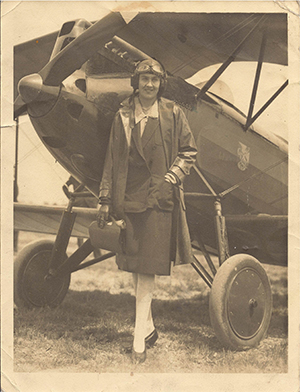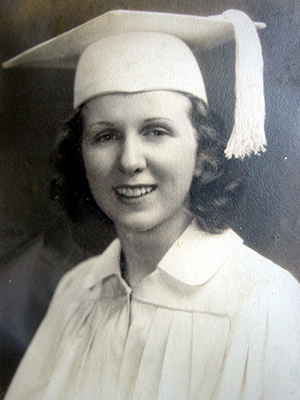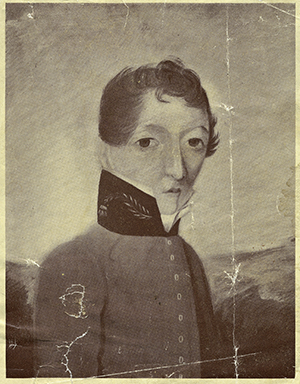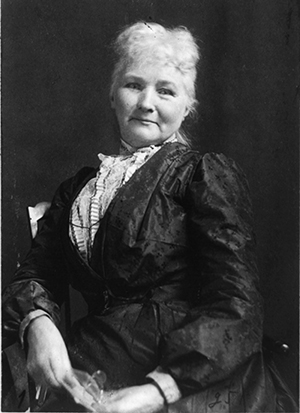HERSTORY: Ireland’s EPIC women
Published in Issue 3 (May/June 2020), Reviews, Volume 28RTÉ1
3 February–9 March 2020 (six episodes)
By Deirdre Foley
Herstory, the social enterprise founded to bring women’s stories ‘out of the shadows and into the light’, partnered with RTÉ, the Broadcasting Authority of Ireland, EPIC the Irish Emigration Museum and Underground Films to create this six-part series, which highlights ‘Ireland’s greatest female trailblazers’. The episodes are easily digestible at about 25 minutes each, and the stories are compelling.

Above: Lady Mary Heath from Limerick—the first woman in Britain or Ireland to gain a commercial pilot’s licence, and the first to parachute from a plane.
The first episode was about the ‘fearless and glamorous’ Lady Mary Heath, from Limerick, who became the first woman in Britain or Ireland to gain a commercial pilot’s licence and the first to parachute from a plane. Heath’s trajectory, even before she started flying, was far removed from that of most Irish women. She was from a wealthy background and even attained a degree from the Dublin College of Science, a fact that was not emphasised in the programme. Lady Heath’s pursuits were certainly inspirational to her contemporaries. In 1935 the secretary of the Irish Women Workers’ Union, Louie Bennett, referred to the new phenomenon of female pilots as part of her protest against proposed restrictions on the employment of women in the Irish Free State: ‘Women pilot aeroplanes across the world and we have ceased to be surprised’. Heath was part of this group that widened the scope of possibility for women in the 1920s and 1930s, and her exploits were regularly reported in Irish newspapers.

Above: Donegal-born Kay McNulty—wrote the manual for the world’s first electronic computer, the ENIAC, in the United States during the Second World War.
The life and career of Donegal-born Kay McNulty serve to highlight, as contributor Angela Byrne remarks, ‘the sub-classification of women’s work’. Her work as a gifted mathematician and programmer and her choice to stay at home after marriage are treated with equal respect in this episode. It was pointed out that McNulty and her female colleagues did not receive the recognition they deserved for some years after they pioneered the field of computer programming by writing the manual for the world’s first electronic computer, the ENIAC, in the United States during the Second World War.

Dr James Barry—born a female but lived and dressed as a male upon entering medical school at Edinburgh University in the early nineteenth century.
Dr James Barry was born as a biological female but lived and dressed as a male upon entering medical school at Edinburgh University in the early nineteenth century. It is critical, as Mary McAuliffe does, to acknowledge and embrace the story of James Barry as ‘trans’ history. McAuliffe’s assertions in this regard are important and, consequently, some other commentators’ use of ‘he’ and ‘she’ interchangeably makes for a somewhat jarring and confused treatment of the subject. This topic is new ground in history, and it is important that we treat such subjects with respect, given that we can never be certain about how Barry did or did not identify in terms of gender. We will never know, for example, what Barry would have thought of being recognised as the University of Edinburgh’s first female graduate surgeon. Barry’s position as a pioneering surgeon and early proponent of public health, hygiene and sanitation is also given its due during this episode, as is the fact that Barry was responsible for the first successful caesarean section in the British Empire in which both mother and baby survived.

Mary Harris ‘Mother’ Jones—a legendary leader in the American labour movement.
Mary Harris ‘Mother’ Jones, the infamous union organiser, emigrated to America from Ireland during the Great Famine, and endured ongoing heartache later in life when she lost her husband and children to yellow fever. While Jones did not come from affluent beginnings, her admittance to education as a young girl in America and her resultant early career as a teacher were certainly building blocks for her later position as a legendary leader in the American labour movement.
Oonah Keogh’s career as a stockbroker in 1920s Dublin is remarkable, if underscored by the fact that she was admitted to the business by her father. While Keogh was undeniably a highly intelligent and accomplished woman, social class buttressed her potential and marriage ultimately ended it, as she left the profession after this point. She is rightly celebrated as a figurehead for women in the financial services sector, although it is again impossible to know whether it was ultimately her choice to cease work after marriage.
An icon for women involved in the arts, Ninette de Valois made ballet a ‘high art’ in Britain and Ireland, and collaborated with W.B. Yeats in bringing ballet to the stage of the Abbey. Like Heath, Barry and Keogh, she was from a very well-off family but became prominent in her own right and established schools of ballet at the Abbey and in London.
It is Herstory’s mission ‘to give the public authentic female role models’. The series certainly succeeds in this regard, and young women in particular will really enjoy the series. The episodes are a useful resource that will hopefully pique the interest of many, and may encourage the general public to consider and reassess the deeply gendered nature of the vast majority of ‘popular’ history. The inclusion of subject experts and family members on each episode—for example, Dr Victoria O’Brien, author of A history of Irish ballet, and Kay McNulty’s daughter, Gini Mauchly Calcerano—adds layers to the stories that historians alone could not achieve.
The elephant in the room, however, is the fact that all of the women featured in the series spent the majority of their lives overseas. The connection of EPIC, the Irish emigration museum, to this project is not made explicit to the viewer and should perhaps have been stressed a little more—the series is not billed specifically as one about emigrant women. What remains to be interrogated in a series such as this is what the factors for female emigration were—how repressive independent Ireland, and the British state before it, was towards women, both legally and socially. Furthermore, it is important to acknowledge that the ‘adventurous’, ‘disrupting’ nature of these women was, in most cases, enabled by their innate privilege and mobility. Even in the lives of such ‘trailblazers’, marriage and childbirth could be a disrupting factor, and they remain so in some women’s careers. In addition to the policy element, for every trailblazer who left there is another activist, homemaker or ordinary worker who stayed. All stories hold equal value. As the Herstory blurb states: ‘We aim to tell the complete, multi-faceted stories of women. It is through telling all facets of herstory—the light and dark—that we acknowledge, heal and transcend.’
Deirdre Foley lectures in the School of History and Geography, Dublin City University.
















